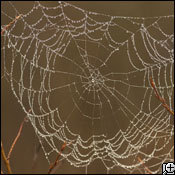A study of pollen captured in spider webs of southern and central Yunnan, China, shows that the sticky webs do a darned good job at capturing and hanging onto pollen grains from local plants. The method may be useful in plant surveys worldwide.
"The [type] of pollen and spores identified from the spider webs can reflect the vegetation of the sampling site," confirms Cheng-Sen Li of Chinese Academy of Sciences and the Beijing Museum of Natural History.
Along with colleagues from China, India and England, Cheng has published a paper on their discovery in the July issue of the journal Review of Palaeobotany and Palynology.
The pollen sampling technique comes as a surprise to at least one spider expert, who had only heard of one other pollen-spider connection.

|
| ©unk |
| A Botanist's Best Friend. |
"For spiders that routinely take down their webs, consuming the silk in the process, it has long been assumed that pollen sticking to the silk is a nutrient source," said Norman Platnick, spider curator at the American Museum of Natural History. "For some very small spiders, that has been thought to constitute a major food source."
The webs that were collected for the study were the largest the team could find, without regard to the species of spider involved, Cheng told Discovery News. They also appeared to be abandoned webs, since they did not look new, the team reported.
"We do not know whether the species of spider is important or not for such work, as we did not find the spider when we collected the web samples," said Cheng. So at least for this initial study, the important thing was that there were just any web-building spiders at all, Cheng said.
After collecting the webs across a swath of countryside, the team then returned to their labs and dissolved the webs away. They then took stock of the pollen and spores that remained.
For the most part, the web pollen reflected the plants found in the collection areas. Strangely, however, the only thing missing in the webs were spores from ferns and mosses. It's not exactly clear why that is, Cheng said, since the wind can easily carry spores. One possibility is the specific spots they found their webs.
"The webs we collected were mostly from the small trees and shrubs," Cheng explained. "While the ferns and mosses were living on the wet ground and their spores were transported mostly by water on the ground."
So at least in this case, it's possible that there weren't many spores of ferns and mosses in the air at the time. In other words, where such spores are more abundant, there's no reason to think spider webs won't be pretty good at catching them too.



Reader Comments
to our Newsletter